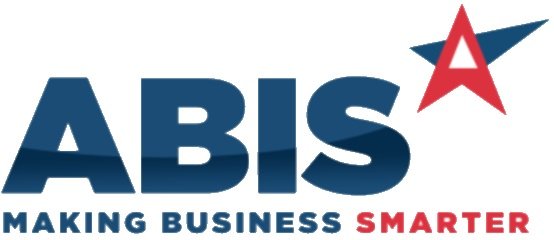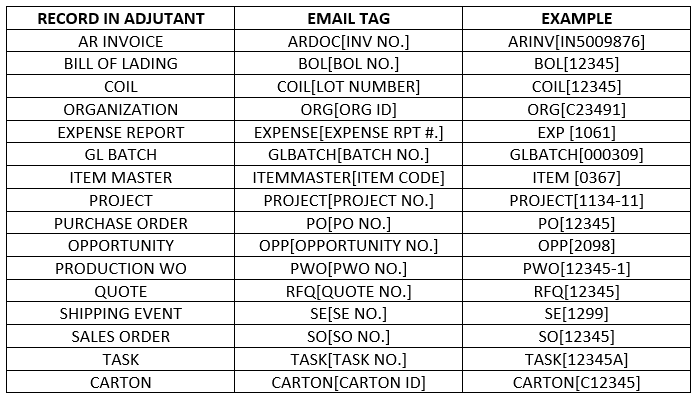Mail Reader and Email Tags
From Adjutant Wiki
(Redirected from Mail Reader and Email Tage)General Information
Adjutant has processes that can read email inboxes and process emails found there into notes, tasks, document vault attachments, and AP vouchers.
Please note that all email tags use brackets before and after the code/ID you're specifying and that no spaces should ever be used in an email tag. Using spaces will cause the MailReader to ignore the tag.
Using Email Tags
ABIS AP Voucher
All AP invoices can be sent to your predesignated email address for AP vouchers or invoices, which will likely be similar to ap@yourdomain.com. There are no tags needed for this address; all attachments will be moved into the AP Voucher folder.
ABIS Inbox
Files other than AP invoices can be sent to your ABIS inbox using a predesignated email address, which will likely be similar to inbox@yourdomain.com, with the following tags in the body (not the subject) of the email:
Multiple files can be sent in one email, and multiple tags can be used in one email. All attachments will get copied into the corresponding document vault folders per the tags you used in the body of the email.
- To attach multiple files to a single quote, attach all the files to one email and add the tag for the appropriate quote to the body of your email.
- To attach a multiple files to both a quote and a purchase order, attach all the files to one email and add the tags for the appropriate quote and purchase order(s) to the body of your email.
Multiple records can be specified within one tag by using commas.
- To attach a file to multiple coils, you could enter the tag as COIL[123,124,125,126]. This will attach everything in your email to coil numbers 123, 124, 125, and 126.
Sub-folders can be specified using the FOLDER[] tag. You can use the FOLDER[] tag with any other email tag.
- To attach a file to PO 12345, in a sub-folder called “Receivers,” use the PO[12345] tag and the FOLDER[Receivers] tag anywhere in the body of your email. Adjutant will create the Receivers folder if it does not already exist.
ABIS Notes
In addition to attaching files to specific records in Adjutant, Notes can be created by sending an email to your predesignated email address for notes, which will likely be similar to notes@yourdomain.com. You can use multiple tags in an email; the MailReader program will attach your note to all of the contacts and organizations you specify.
The sender of the email will be listed as the Owner of the note if:
- The sender is a Note Owner (attribute on the contact record), and
- The email address is listed on their contact record (one of the two email addresses).
- Otherwise, the owner will be blank.
The sender of the email will be listed as the Add User of the note if
- The sender is a User in Adjutant (attribute on the contact record), and
- The email address is listed on their contact record (one of the two email addresses).
- Otherwise, the Add User will be listed as MailSys.
The first From: address in the email body is used by the MailReader to figure out which contact and organization the note should be linked to. If the contact (the From: address) does not exist in Adjutant, then the MailReader will not be able to link your note to the correct contact/organization. The MailReader skips over internal addresses (those ending in the same domain name as your company's website) when it looks for contacts to link to.
The bottom of every note created by the MailReader contains the sender's email address and the recipients' email addresses (To: and CC:).
Attachments will be stripped off of the email and attached to the note. They can be viewed in the Document Vault for the note.
The following is a list of tags that can be used in the body of an email that is sent to your Notes email address:
CUSTNO[X] - Organization, where X is the Organization ID.
FL[X] - Follow Up Date of the note, where X is the Date. The date MUST be formatted as XX/YY/ZZ, where X is the month, Y is the day, an Z is the year. Using this tag sets the Note Status as Open.
PRI[XX] - Note Priority code where XX is the code value from the NOTEPRIORITY rule.
OPPID[X] - Project Opportunity, where X is the Project Opportunity Number.
PROJID[X] - Project, where X is the Project ID. Not as common as using the Project Number.
PROJNUM[X] - Project, where X is the Project Number (if you are using alphanumeric Project numbers).
SVCORD[X] - Service Order (Task), where X is the Service Order Number.
CID[X] - Company ID, where X is the CID.

